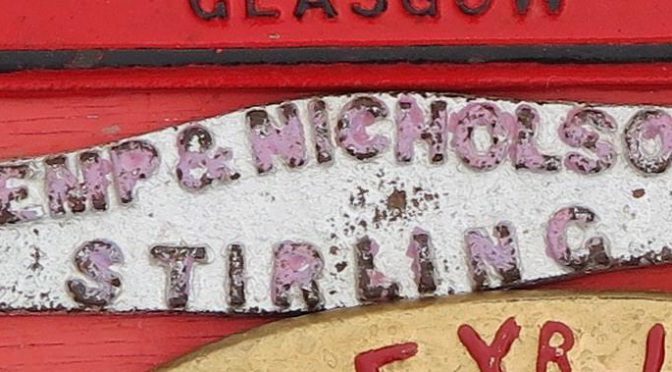K is for …
Robert Kay & Son, agricultural implement makers and body builders, Stirling Road, Milnathort, Kinross-shire
James H. Kelly, all kinds of farm carts, waggons, mill carts &c, Van Street, Parkhead, Glasgow
Kemp & Nicholson, Scottish Central Implement Works, Stirling, Stirlingshire
John Kerr, smith and agricultural implement maker, Corstorphine, Midlothian
John Kirkpatrick, 32 Irish Street, Dumfries
James Kirkwood, Tranent Foundry, Tranent, East Lothian
W. H. Kirkwood, agricultural implement maker, Lothian Bridge, Midlothian
S. Koronka & Co., Steeplehill Works, Ceres, Fife
Robert Kyd, Trades Lane, Coupar Angus, Perthshire
Kydd & Doig, Kingoldrum, Kirriemuir, Angus
Under the letter K we have a number of names of key makers who were known in their localities. In Stirlingshire Kemp & Nicholson of the Scottish Central Implement Works was well known. The company conducted business from their premises in Dumbarton Road, Stirling, as Kemp, Murray & Nicholson, in 1858. The company had further business activities further east in East Lothian. In the North British Agriculturist in November 1858 stated that “Kemp, Murray & Nicholson have removed from their branch establishment, Haddington, to their headquarters in Stirling where they have been in business for the last 10 years and where their business will henceforth be exclusively carried on.” By 1859 the company described itself as agricultural implement manufacturers, though by 1870 it had expanded its range of trades to be joiners, agricultural implement and reaping machine makers and engineers, activities that it became renowned for in the following decades.
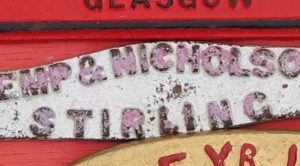
The company underwent a number of significant changes in its early years: the partnership changed in 1876 so that it became renamed Kemp & Nicholson, a title it retained until the 1930s; in 1884 it moved from Dumbarton Road to more commodious premises at Cow Park Siding which adjoined the goods station of the North British Railway; it set up the Scottish Implement Works in the mid 1880s; by the 1890s it became an important agent as well as manufacturer of agricultural implements and machines, selling manufactures from the leading makers throughout Britain and further afield (this activity had started in the early 1870s with the company stated that “in addition to implements of their own manufacture, they have always in stock implements and machines of the best English manufacture”); by the mid 1890s it was also a cart, van and wagon builder.
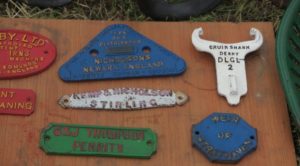
The company was quick to publicise its manufactures to the farmers of Scotland. From 1858 until 1931 it was a regular exhibitor at the Highland Show, also having an extensive stand. It was also a regular advertiser in the Scottish agricultural press, being one of the few Scottish companies to advertise throughout the year.
The company was renowned for a number of types of implements and machines. From the 1870s, at the height of the development of local harvesting machinery, it quickly established its reputation as a maker of reaping machines, for which it continued to be renowned until the 1900s. By 1890 its specialisms were reapers, mowers, horse takes, grubbers, harrows and ploughs. In 1903 these specialisms were reapers, mowers, horse rakes, harrows, food coolers and turnip slicers, and two years later reapers, mowers, horse rakes, grubbers, harrows, ploughs, carts, vans, turnip cutters and hay presses. These were to be its staple manufactures into the early 1930s.
The company was highly recognised for its manufactures. In 1857 it was awarded 4 sovereigns for the best three row sowing machine for beans at the Highland Show. The company received a long list of awards from the Highland Show in following years: best harvest cart (1857), commended best sowing machine for grass seeds (1858), bronze medal for second best harrows for heavy land (1860), bronze medal for second best harrows for light land (1860), bronze medal for the second best harrows for light land (1860), bronze medal for second best drill sowing machine for grain (1860), best sowing machine for grass seeds (1860), best one harvest part with harvest frame (1860), best sowing machine for grass seeds 91861), highly commended combined reaping and mowing machine (1861), commended for food cooling barrows (1868) silver medal for collection (1870), medium silver medal for collection (1871), medium silver medal for collection (1873), medium silver medal for collection (1875).
The company continued to trade until shortly after the death of Major Kemp Smith in March 1930.
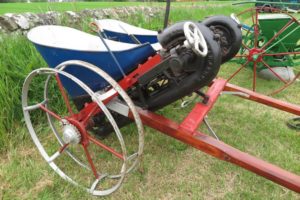
Robert Kydd, Trades Lane, Coupar Angus, was already a well-known agricultural implement maker from the mid-1870s. He brought attention to his manufactures in the North British Agriculturist on 28 July 1875. He was a regular exhibitor at the Highland Show from 1879 until 1900 as well as a keen competitor of his implements and machines. He entered the Highland Society’s trial of potato diggers in 1881 and the Royal Agricultural Society of England’s trials of potato raising machines in 1888. He also entered the Highland Society’s trial of combined reapers and binders, or lifting and binding machines in 1882.
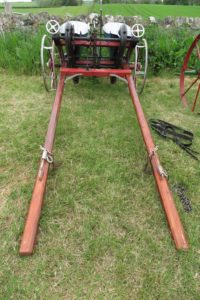
Kydd quickly gained a reputation for his implements and machines. In 1887 his two row potato planter was “now so well and favourably known as to require no description or comment”. By 1896 the Dundee Advertiser could state that “he has been getting quite a name far afield”. He was already well noted for his potato diggers as well as ploughs and drill ploughs. All of his implements showed “good workmanship”. He was recorded in trades directories as an implement maker until at least 1900 and as a smith until 1913.
The name of Kirkwood was well-known in the Lothians in the nineteenth century. One of the names that keeps on cropping up over and over again in the farming papers of nineteenth century Scotland is William Kirkwood, agricultural implement maker, Lothian Bridge, Dalkeith, Midlothian.
William first appears in the North British agriculturist in 1856 as an implement maker at Duddingston. He moved from there in late 1865 when he adverts record William Kirkwood, implement maker, Lothian Bridge (late Duddingston). He undertook a number of trades: as agricultural implement maker, smith and as smith and implement maker.
William was a regular exhibitor at the Highland Show. Although he exhibited in the main show districts including Dumfries, Kelso, Stirling, he most regularly exhibit at Edinburgh. He exhibited at that last location in 1859, 1869, 1877, 1893, 1899, and 1907. At the Show he was an award-winning maker, winning numerous prizes. They included:
1857 – award of 2 sovereigns for best sheep fodder rack
1858 – award of 2 sovereigns for best hand stubble or hay rake
1858 – award of 5 sovereigns for best feeding troughs for sheep
1859 – award of L2 for best hand stubble or hay rake
1859 – award of L1 for best feeding troughs for sheep
RHS 1859 – award of L1 for best wheelbarrow of malleable iron
1860 – award of 1 sovereign for best feeding troughs for sheep
1860 – award of 1 sovereign for best wheelbarrow of malleable iron
1860 – commended, hand stubble or hay rake
1861 – award of 3 sovereigns for best machine for pulverising guano etc
1861 – award of 1 sovereign for best feeding troughs for sheep
1861 – award of 2 sovereigns for best sheep fodder rack
1873 – award of medium silver medal for Norwegian harrow
William died in March 1911. His obituary appeared in the Edinburgh evening news on 1 April 1911. It provides some further information about his business and the man at its helm:
“Mr William H. Kirkwood, agricultural implement maker, Lothian Bridge, died suddenly yesterday, after a few days’ illness, at the age of 63 years. Deceased, who was a native of Edinburgh, began his engineering career in the Singer Sewing Machine Works, in the West of Scotland, and on the death of his father, he acquired the engineering business at Lothian Bridge. Mr Kirkwood was particularly successful in the manufacture of ploughs, and gained various awards from the Highland and Agricultural Society, and other societies, for improvements both ploughs and harrows. He took a lively interest in the affairs of the Newtongrange district, was for several years a member of the Parish Council, and was senior elder and session clerk for Newbattle Parish Church.
